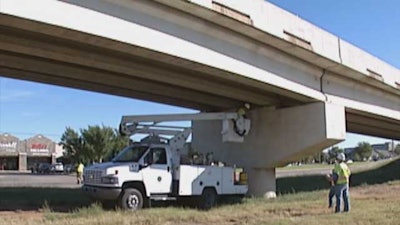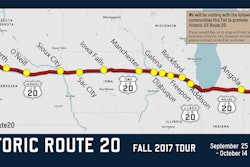 Oklahoma DOT workers inspect a bridge after an earthquake.
Oklahoma DOT workers inspect a bridge after an earthquake.Saiid Saiidi, a professor of civil and environmental engineering at the University of Nevada, Reno, served as project leader in testing new bridge designs with connectors that he says can better withstand violent temblors and help speed reconstruction after a major quake causes damage, the Montreal Gazette reports.
Scientists conducted tests using a “shake table” to simulate a magnitude 7.5 earthquake by shaking a 100-ton, 70 foot-long bridge model with large concrete columns and beams for about 30 seconds at a time to see how well it would hold up. Some of the columns were displaced nearly a foot before returning to their original spots. After the test, graduate students measured and marked tiny fractures, but found no major structural damage.
“The bridge has done better than we expected,” Saiidi told the news agency. He said the designs that were tested used special types of connectors to link together prefabricated bridge parts, including ultra-high performance concrete. Although the elements had been tested by themselves, they had not been tested in a bridge model that was subjected to realistic earthquake motions.
The “pipe pin” connector was developed by California Department of Transportation bridge designers. The pin consists of a steel pipe that is anchored in the column and extended into a steel can embedded in the beam. A gap between the steel pipe and the can allows the extended segment to freely rotate inside the steel can, preventing bending of the protruded segment inside the can. The connectors attach prefabricated concrete and other materials to an existing bridge foundation to speed repair and reconstruction.
Some of the design work has been used in a highway off-ramp being built in Seattle, which will be the first bridge in the world to use flexible columns and reinforced bars made out of a metal alloy with titanium that bends and then springs back into shape.









